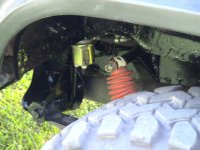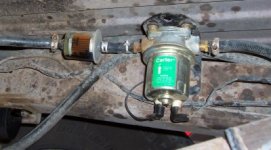The couple of 'returnless' pump assemblies that I've looked at were not a relief internal to the pump. They were a port in the fuel pressure regulator that was part of the whole pump/sender/FPR assembly, but distinctly separate from the pump section. I'm calling that a 'return' as it is not an integral part of the actual pump itself. One such assembly truly was returnless, there was no FPR or anything like one. It would appear that the computer controlled fuel pressure via a PWM scheme or something like it.
My current DD suffers from hot shut-down percolation far more than my old 302 DD. The current car's lay-out, which includes a by-pass regulator and return system, should be less prone to vapor lock, and it is. However due to it's lay-out it should also not suffer from hot shut-down percolation as much and it is as bad or worse about that than the old car was.
The EPA specs can claim anything that they want, I'm relating my real world experiences with daily driving a carb spanning a considerable number of years. Part of the problem could be KA fuel, who knows? I do know that ARCO fuel is the worst for percolation and run-on. I don't buy it for carb'd cars.
Pressure vs. vacuum as related to boiling point is a curious thing. From my looking into it a slight depression in pressure does a whole lot more to lower the boiling point than a slight increase does to raise the boiling point. It does not appear to be a linear relationship.
Getting back to the OP's question, the less distance there is from the tank to an electric pump the better. This is the section of fuel line most likely to have vapor lock due to it being under a slight vacuum. Keeping it as short as possible is a good thing. Making it as large as possible to reduce restriction is also a good thing. And definitely use vacuum rated hose there. Emissions barrier hose may be a good call there as it's liner is fairly stiff and may not collapse under vacuum. Won't be cheap though you may never have to replace it. I've been testing it for almost a year on Pusk-Lok/Barb-tite type "socketless" hose ends. No leaks, no failures at TBI fuel pressures and under vacuum.
There's something to be said for the pump being below as much of the fuel in the tank as is reasonable. I'm not sure which is more important, that, or keeping the suction line as short as possible. They're both important and they're usually mutually opposing goals.















